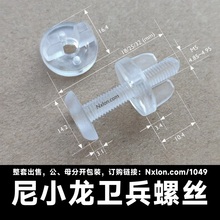Type 1 Hexagonal Slotted Nut
©Nxlon.com D/T:

The Type 1 hexagonal slotted nut is a common type of nut. The following is the relevant introduction to the Type 1 hexagonal slotted nut:
Structural Features of the Type 1 Hexagonal Slotted Nut
Hexagonal Shape: It has a hexagonal shape, which makes it convenient to use tools such as wrenches for tightening and loosening operations. It can provide a large force application surface, ensuring that the nut will not slip easily during the tightening process.
Slotted Design: There are two or more radial slots processed on the top of the nut. These slots are used in conjunction with the holes on the bolt. By inserting connecting pieces such as cotter pins, it can prevent the nut from loosening due to reasons such as vibration during use, playing a reliable anti-loosening role.
Specification Dimensions of the Type 1 Hexagonal Slotted Nut
Thread Specifications: The Type 1 hexagonal slotted nut has a variety of thread specifications. Common ones include M3, M4, M5, M6, M8, M10, M12, M14, M16, etc. Among them, "M" represents the metric thread, and the following number represents the nominal diameter of the thread, with the unit being millimeters. Different application scenarios will select appropriate thread specifications according to the size of the bolt and the force-bearing requirements.
Nut Thickness: The thickness of the nut is usually about 0.8 to 1 times the nominal diameter of the thread. For example, for a Type 1 hexagonal slotted nut with M10, its thickness is approximately between 8mm and 10mm. The actual thickness may vary depending on the grade of the nut and specific standards.
Distance Across Flats: The distance across flats of a hexagonal nut refers to the distance between two opposite sides. For common thread specifications, there are corresponding standard values for the distance across flats. For example, the distance across flats of a Type 1 hexagonal slotted nut with M8 is 13mm, and that of M10 is 16mm.
Application Fields of the Type 1 Hexagonal Slotted Nut
Mechanical Manufacturing: It is widely used in the assembly of various mechanical equipment, such as machine tools, automotive engines, industrial robots, etc. It is used to connect and fasten various components, ensuring that the connections between the components of the equipment are firm and reliable during operation, and can withstand certain vibration and impact loads.
Construction Engineering: It is often used in the connection of building structures, the installation of steel structures, and the fixing of some construction equipment. For example, in the construction of steel structure bridges, it is used to connect components such as steel beams and steel columns; in the assembly of construction equipment such as tower cranes, it is used to fasten various structural components.
Power and Electrical Engineering: In the installation and maintenance of power equipment, such as the assembly and fixing of transformers, switchgear, utility poles, etc. It can ensure that the connection parts of electrical equipment will not loosen due to vibration or other external forces during long-term operation, ensuring the safe and stable operation of the power system.
Materials and Surface Treatments of the Type 1 Hexagonal Slotted Nut
Materials: It is usually made of medium carbon steel or medium carbon alloy steel, such as 45 steel, 40Cr, etc. After appropriate heat treatment, these materials have high strength and hardness and can meet the fastening requirements of general mechanical connections. For some Type 1 hexagonal slotted nuts used in special environments, stainless steel materials such as 304 stainless steel and 316 stainless steel will be used to improve the corrosion resistance and oxidation resistance of the nut; in some occasions with extremely high strength requirements, high-strength alloy steel materials will also be used.
Surface Treatments: Common surface treatments include galvanizing, nickel plating, blackening, etc. Galvanizing treatment can form a zinc protective film on the surface of the nut, effectively preventing the nut from rusting, and is suitable for most outdoor and general industrial environments; nickel plating treatment can not only improve corrosion resistance but also make the surface of the nut smoother and more beautiful, with good decorative properties, and is often used in occasions with high requirements for appearance and corrosion resistance; the nut after blackening treatment has a certain rust prevention ability and a relatively simple appearance, and is often used for the internal connections of some machinery with low requirements for appearance but a certain rust prevention performance.
Installation and Disassembly of the Type 1 Hexagonal Slotted Nut
Installation: Screw the nut onto the bolt and use a wrench to tighten the nut to the specified torque value. During the tightening process, ensure that the nut fits well with the surface of the connected part and avoid any skewing or eccentricity. Then, insert the cotter pin into the slot of the nut and the hole of the bolt as required, and spread the tail of the cotter pin to prevent the nut from loosening.
Disassembly: First, remove the cotter pin, and then use a wrench to loosen the nut. If the nut is difficult to disassemble due to long-term use or rust, etc., you can first spray a rust remover on the threaded part and wait for a while before disassembling. During the disassembly process, pay attention to protecting the threads of the nut and the bolt to avoid damage, so as to facilitate subsequent reuse or replacement.
尼小龙塑料螺丝-塑料螺母-尼龙垫圈-塑料铆钉
内3.2外7.0白色塑料直通柱ABS隔离柱
订购链接:Nxlon.com/1012
内3.2外7.0白色塑料直通柱ABS隔离柱是一种以ABS(丙烯腈 - 丁二烯 - 苯乙烯共聚物 )为材质的PC板隔离柱。
尼小龙塑料SB通孔扣式护线套
订购链接:Nxlon.com/1051
绝缘塑料SB通孔扣式护线套16-19-22-25尼龙电缆电源线塑胶线孔盖质:尼龙,颜色:黑色、白色;规格:SB-16、SB-19、SB-22、SB-25等。
塑料螺丝保护套-螺母保护帽
订购链接:Nxlon.com/1035
塑料螺丝帽保护套-塑料螺母保护帽M8M10六角塑料螺母保护帽外六角塑料螺丝盖罩螺栓螺丝装饰防尘套,尼小龙螺母保护帽材质:聚丙烯 Polypropylene,型号:S-12-PP, S-13-PP, S-14-PP, S-16-PP, S-17-PP
R3560-塑料铆钉-尼龙铆钉
订购链接:Nxlon.com/3560
R3560-塑料铆钉-尼龙铆钉塑料铆钉-尼龙铆钉-汽车塑胶铆钉-尼小龙尼龙铆钉R2.6R3.5R4R5塑胶柳钉子母铆钉快捷紧固件塑料卡扣。
内3.2外7.0黑色塑料直通柱ABS隔离柱
订购链接:Nxlon.com/1013
国标圆形直通柱垫片垫圈材质:塑料ABS树脂;内径:M3系列=3.2mm,M4系列内径=4.2mm;外径:M3M4系列外径都是7mm;高度:2到15mm









